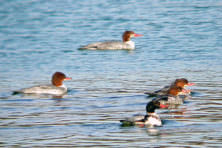Roy Lukes: Mourning Doves
- Share
- Tweet
- Pin
- Share

How well I remember the early spring of 1952 when I was a junior at the Wisconsin State College at Oshkosh, learning how to become a teacher. One of the biology professors had posted a large chart in one of the halls of the main building on which he invited those students and professors interested in birds to list sightings of early spring bird arrivals, including species seen or heard, the date and location, and your name.
One of the few wild birds I had come to know well was the Mourning Dove, with which I became very familiar with during the summer of 1943 when I had 14 lawn jobs, all with “push” man-powered mowers. It was in the towering American Elm trees on John and Martha Proctor’s property along Milwaukee Street, whose lawn I cut, that so many Mourning Doves sang their doleful “cooing” songs hour after hour. The dozens of dense Norway Spruces nearby offered them good nesting sites.
I don’t recall the exact date I heard my first Mourning Dove in Oshkosh but it was seen and heard while I was on my way to the public museum, and I know that my one and only entry, the Mourning Dove, on the bird arrival chart at the college was one of the first of that spring.
Apparently the wintering range of Mourning Doves in the Upper Midwest has moved northward considerably during the past 50 years because these sleek, 12-inch, gray-tan birds with the long pointed tails now appear on most Christmas bird counts in the state. Our daily flock varies between five and 15, with their morning arrival at the feeders coming well before sunrise, and their last mass visit being just before dark.
Charlotte and I planned our passive solar home, with the help of an experienced architect, to take advantage of the winter sun to supply free heat on sunny days, and it works to perfection. Once the deciduous trees have dropped their leaves we have an expansive view of the sky to the south and southwest. I must admit that some of the most awesome bird dramas, watched through our second floor large south facing windows, involved a Mourning Dove being chased by a Cooper’s Hawk. We never have seen who won any of the chases, but, more than once, have found a pile of dove feathers atop the snow halfway down our long driveway.
Recently we were up well before daylight to clear snow off the feeders and bring more food to the hungry early birds. Customarily the doves land first in the highest branches of the Basswoods at the edge of the yard. Once assured that the “coast is clear,” down they fly to eat on the ground under the feeders.
Years ago 30 to 40 would show up when we scattered cracked corn on the driveway. However, the corn attracted other birds we did not want as well as raccoons from every direction. Now the doves must be happy with spilled sunflower seeds and bits of suet that fall to the ground.
One morning many doves were here eating everything they could find. I made mention to Charlotte that it was strange that no other small birds, especially chickadees – among the first every day, had arrived at the feeders. They were at least 30 minutes behind schedule.
In the split second that we took our eyes off the doves and the other bird feeders there was a sudden whoosh of dove’s wings and, just that fast, a loud bang against one of the large south-facing windows in the den directly below our second story dining room. I immediately ran downstairs fully expecting to see a Mourning Dove dead or floundering on the cement patio outside the windows.
Indeed, there was a Mourning Dove, with a large female Sharp-shinned Hawk perched on top, clutching the dead dove with one foot. Slowly I eased up to the window to within five feet of where the two birds rested. Fortunately the hawk’s squared-off tail was slightly fanned, providing me with the perfect clue that it was a Sharp-shinned rather than a Cooper’ s Hawk, whose tail has more white at the end and is more rounded.
Seeing me, the female hawk, weighing approximately nine ounces (according to my bird banding manual), took off with great difficulty, barely managing to carry the dead four-ounce Mourning Dove only several inches above the snow, to the thicket of Quaking Aspens 50 feet from the house. The accipiter immediately began plucking its victim, but with each mouthful of feathers she tore off the dove, both birds sank deeper into the soft snow.
After half fluttering and dragging her prey to several different snowy sites, the “sharpie” finally succeeded in pulling the dove beneath the lowest boughs of a White Spruce where the ground was bare. By the way, all accipiters in northeastern Wisconsin, including the Northern Goshawk, Cooper’s Hawk and Sharp-shinned Hawks, pluck their victims before consuming their flesh.
It took the other birds a half-hour or longer before they returned to the feeders, and you can imagine how on edge they were for the remainder of the day. Come to think of it, wild birds in general are constantly on the alert as they exist from day to day in their “survival of the fittest” environment.
It’s for this very reason that we feel it’s so vital to provide wild songbirds with adequate evergreens and brushy thickets close to their feeding areas that will offer them speedy refuge from their natural predators. Brush piles also serve the small birds extremely well as nighttime roosts and also hiding places from their enemies that include the accipiter hawks and feral cats.
We lure the birds to our property with black oil sunflower seeds, Nyger thistles seed, suet and Marvel Meal. For all the great enjoyment we derive from watching the birds, it is no more than right that we reciprocate by providing them with as much protection from wild predators as we can.




